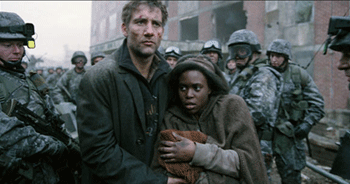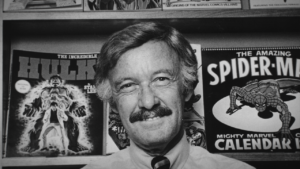‘Children of Men’: Universal’s Orphaned Masterpiece
How do you make the best movie of the year -- possibly the decade -- and still get pummeled at the box office by Ben Stiller and a CGI dinosaur? Sheerly Avni, Truthdig's movie critic, lays it out in 10 easy steps.
Here’s how Hollywood’s “creative tension” between Commerce and Art really works: Commerce lures Art into his lair with roses and chocolate, swears his undying love, and then quickly leaves her for nights away at a nearby strip club called The Bottom Line. Then he throws the furniture and smacks her around the kitchen a bit, just to let her know who’s boss, and when she’s finally got her bags packed, to move back in with her sister The Theater perhaps — Commerce shows up with another batch of roses and convinces her to stay.
There’s not a lot of love there, but it’s how the babies get made.
Take “Children of Men,” for example, by Alfonso Cuarón, the Academy Award-nominated director of both “Y Tu Mamá También” and the only good Harry Potter installment. His movie boasts stellar performances by Clive Owen, Chiwetel Ejiofor, Julianne Moore and Michael Caine. It’s based on a critically acclaimed novel by P.D. James, and what a story: a desperate chase set in a dismal England of 20 years from now, on a dying Earth that has been devastated by nuclear bombings, immigration conflicts, plague and environmental damage.
Not to mention the looming end of the human race — for the past 18 years, no babies have been born. Enter a young pregnant illegal who is therefore mankind’s last hope, and you have the kick-ass sci-fi premise of a lifetime. By all rights, “Children of Men” should be a blockbuster.
But as J. Hoberman wrote in the Village Voice last month, Universal has done everything it can to bury its treasure, treating the movie “like a communicable disease.” Dumped in limited release on Christmas Day and finally released wide this past weekend to just 1,200 theaters, “Children of Men” still managed to come in third, after “Night at the Museum” and “The Pursuit of Happyness.” It has also been included on several critics’ top-10 lists, and is currently ranked number one on the New York Times’ viewing poll.
Cuarón has pulled off the near-impossible: He’s made a big-budget, politically charged, visually stunning film — complete with hot leads — that grips as much as it entertains. By following these 10 easy steps, you too can make your own $80-million unpromoted masterpiece.
You don’t stand a baby’s chance in 2027 of winning an Oscar, but hey, at least you’ll keep your integrity.
1. Show no mercy. The fascist government of future London (one of the few surviving nations) supplements its citizens’ rations with anti-depressants and a suicide pill called Quietus, which is plugged on the ravaged city’s moving billboards with the slogan, “You choose when.”
Heroes do not take Quietus. They trade in the right to choose when to die by choosing what to live for. In cinematic terms, that means death can come at any time — even to someone you love, even in the first act.
2. Crack a Joke. Grim settings do not require grim performances. Joan Didion says that we tell stories in order to live, but Lenny Bruce and Richard Pryor knew that jokes are how we bear it.
The humor in this movie, and there is much of it, doesn’t lessen its dramatic impact — rather it helps us connect with these men and women as they struggle to hold on to their humanity in world with no human future. Significant portions, including a car chase in which none of the characters can get their vehicles to start, play like high farce. And even the most essential plot point of the film is revealed not by a text at the bottom of the screen or by a last-minute printed prologue but by a very stoned and barely recognizable Michael Caine telling a joke.
3. Love your backgrounds. The eye candy is stellar: Clive Owen as Theo, an alcoholic bureaucrat who suddenly finds himself thrust into a heroic role, Chiwetel Ejiofor and Julianne Moore as rebel leaders, and stunning newcomer Claire-Hope Ashitay in the role of Kee, the young refugee trying to bring her baby to term. There has rarely been a group of actors as likely to warrant nonstop close-ups. But in several of his interviews, the director has discussed the pact he made with long-time cameraman Emannuel Lubezki — to return to the strategy they followed in “Y Tu Mamá También.” In that movie, the love affairs were between not two, or three, but four: A woman, two boys, and Mexico herself. And actors always shared the screen with the world they moved through, and thus Cuarón’s political readings of his own country’s class wars told themselves. He never had to push the message.
4. On that note. Just hire Lubezki, and do what he tells you to do.
5. Women are neat! And handy! And versatile! The trope of the man who has to carry the woman to safety is one of the oldest in cinema, but Theo’s personal connection to his charge is deeper and more moving than a simple love affair. His other female sidekick is a homily-spouting hippie, the kind you wouldn’t want to be stuck with on a life-or-death chase — unless she turns out to be a trained midwife.
6. Beware Captain Kirk. You know that scene, the one where a blowhard pops up between gunshots to explain the moral of the story? It’s the scourge of American popular entertainment, from “On the Waterfront” to every episode of “Star Trek” and on to “Crash,” “Munich,” “Blood Diamond” and all the way through. It sucks. It out Herods Herod, pray you, and Cuarón avoided it.
7. Remember that we warned you: By following Rule 6, you have effectively disqualified yourself from any chance to thank the academy.
8. Be Mexican. Along with his countrymen Guillermo del Toro (“Hellboy,” “Pan’s Labyrinth”) and Alejandro González Iñárritu (“Amores Perros,” “21 Grams,” “Babel”), Cuarón is redefining how we conceive of genre. One could make some sort of disparaging remark about how the media lump these entirely different artists together just because they are Mexican, if it were not for the fact that they are actually close friends and collaborators. See all three interviewed on Charlie Rose, where Iñárritu explains that “we like to keep our forks in each other’s salads.”
9. We’re not stupid. If there is a bright side to our hyper-accelerated technological death-march, it’s that we’ve adapted some neat new skills: We talk on cell phones, play Tetris, instant-message our friends and watch “American Idol” all at the same time, and that means we can follow the conversation between two characters even while the camera pans around the room to provide us with essential visual cues that help us reconstruct the story. We will get it.
No need for clumsy establishing dialogue, no solemn voiceovers, or subtitled meetings at Parliament. Cuarón uses images to tell us what we need to know: Through graffiti, TV graphics, and even the clippings and photographs on a pothead’s desk.
10. Pack your bags: Let’s say you get past the producers, there’s another hurdle. After they screen your baby, the good folks at marketing can still get you fired — and replaced by that promising A.D. from “American Pie VIII.” Relax. There’s always Mexico.
Your support matters…Independent journalism is under threat and overshadowed by heavily funded mainstream media.
You can help level the playing field. Become a member.
Your tax-deductible contribution keeps us digging beneath the headlines to give you thought-provoking, investigative reporting and analysis that unearths what's really happening- without compromise.
Give today to support our courageous, independent journalists.






You need to be a supporter to comment.
There are currently no responses to this article.
Be the first to respond.